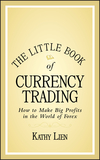The Little Book of Currency Trading
 The Little Book of Currency Trading: How to Make Big Profits in the World of ForexISBN: 978-0-470-77035-1
Hardcover
224 pages
December 2010
This is a Print-on-Demand title. It will be printed specifically to fill your order. Please allow an additional 15-20 days delivery time. The book is not returnable.
Learn more about this book
|
|||||||
The Top 10 Mistakes of Currency Traders and How to Avoid Them
Mistake #1: Trading Out of Boredom or Anger – Whether trading for a month, a year, or a decade, there is always an initial adrenaline rush. However, being bored and seeking excitement is one of the worst reasons to trade. Forcing a trade can eventually lead to losses. Being angry is even worse. The most dangerous time for any trader occurs right after a major loss. The instinct for revenge trading (the desire to get it all back at once) can be far more damaging than the initial loss. It is much better to chip away at the losses by assuming less and less risk until the losses are recovered.
Mistake #2: Having Unrealistic Expectations – Even the best fund hedge managers in the world are not able to make 1,000 percent return, let alone 360,000 percent return on a consistent basis. Having unrealistic expectations encourages greater risk taking which is one of the primary reasons why many new traders blow up their accounts. Seasoned forex traders are happy if they can beat the performance of the S&P 500 and elated if they can consistently generate double digit returns every year.
Mistake #3: Taking Highly Correlated Trades – What many new traders cease to realize is that different currencies will often move in the same direction. For example on any given day, if the Australian dollar is up against the U.S. dollar, there is a very good chance that the New Zealand dollar appreciated as well. Many new forex traders will naively go long both currencies, which is in effect, doubling up on the same position. This redundant exposure could be a big mistake because if one comes crashing down, there is a good chance the other will follow.
Mistake #4: Failing to Use a Stop – It goes without saying that all traders should use a stop. Trading at its core is ultimately an exercise in controlling the chaotic and often unpredictable markets. If you do not use a stop, you are at the mercy of the market and lose all control of your trade.
Mistake #5: Taking Unnecessary Risks – When it comes to trading, holding a position over the weekend when the finance ministers and central bankers are holding a summit is an example of taking an unnecessary risk. The outcome of these meetings is oftentimes unpredictable and can trigger a gap open on Sunday evening. Staying on top of upcoming news releases and events can help new traders avoid exposing the position to unnecessary risks.
Mistake #6: Being Too Patient With Losers and Not Patient Enough With Winners – Many traders fall victim to the mistake of nursing their losers until they become so large that it wipes out their account. Yet, these are most likely the same traders who will abandon their trades as soon as it turns a small profit. It is generally smarter to bag a small profit early and leave open a part of the position in case the move begins a big one.
Mistake #7: Being a “Possum Trader” – Leave the position open, close your eyes, cross your fingers and hope that the trade will work itself out. Unfortunately this almost never happens and more often than not, the losses become even greater.
Mistake #8: Taking on Too Much Leverage – Risking anything greater than 5 to 10 percent of your account on any one trade is financial suicide. Leverage is a wonderful drug when the trade moves in your direction but it is pure poison when the market is aligned against you.
Mistake #9: Over Optimizing Your Strategy – Markets are dynamic and their drivers change with time and therefore it is important to use the appropriate strategies in the right trading environments. For example, applying trend following or breakout trading strategies in quiet range-bound environments will usually lead to be more losers than winners.
Mistake #10: Becoming a Demo Billionaire – Nothing can replace live trading. Just because you can make 500 percent return in your demo doesn’t mean that you will be able to do the same in a live account. Once you start to see losses of $1,000 or $5,000, nervousness will cause you to question whether you should remain in the trade. One of the unique advantages of the forex market is that brokers provide new traders with different sized accounts that allow them to ease into live trading.






